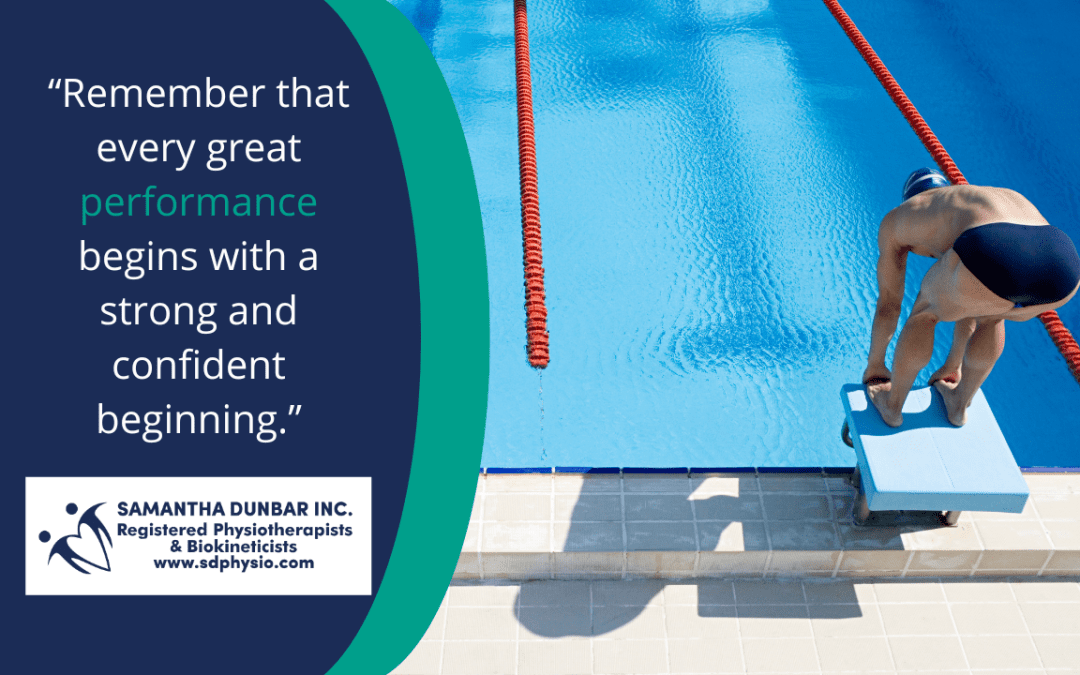It’s the moment when athletes take off from the blocks, attempting to gain an advantage in speed and position.
However, the image below illustrates a more humorous take on this important aspect of swimming. Let’s look at how this image relates to both physiotherapy and biokinetics, emphasising crucial lessons in a light-hearted way.

The image shows three swimmers on staggered blocks, each with a different stance, ready to dive into the pool. Meanwhile, a starter stands in the water, about to signal the start of the race.
Each swimmer’s posture and expression tell a unique story:
The confident swimmer: Closest to the starter, this swimmer displays an aggressive stance, leaning forward with hands poised. This swimmer is confident and ready to maximise their explosive power from the start. This swimmer’s posture emphasises the importance of leg strength and coordination. The starting phase in swimming demands a powerful push-off from the blocks, requiring strong quadriceps, hamstrings, and calf muscles.
The anxious swimmer: In the middle, this swimmer appears cautious, with a less committed posture. They might be concerned about timing or technique, highlighting how mental readiness can affect physical performance. Anxiety can significantly impact an athlete’s performance. This swimmer’s hesitation highlights the need for psychological preparation. Techniques like mindfulness, breathing exercises, and visualisation can help manage nerves and improve focus.
The hesitant swimmer: Closest to the starter, this swimmer looks hesitant and is exhibiting poor diving posture. This illustrates the importance of preparation and confidence in starting strong as well as the significance of pre-race routines and preparation.
While the nature of the image brings a smile, it also conveys valuable insights for physiotherapists and biokineticists:
1. The importance of technique and posture
Each swimmer exhibits a unique posture, emphasising the need for proper technique.
Biokinetics practitioners can use this as a teaching moment to stress the importance of correct body alignment and posture during starts. Proper form is essential to prevent injuries and ensure efficient movement.
2. Mental readiness and confidence
The swimmers’ expressions range from confident to hesitant, showcasing the psychological aspect of performance.
Physiotherapists should address the mental aspects of recovery and performance. Techniques such as visualisation and mental conditioning can help athletes maintain focus and confidence.
3. Individualised training and preparation
The differing levels of preparedness suggest that training should be tailored to individual needs.
Practitioners can develop personalised programs that focus on strengthening weaknesses and enhancing strengths, ensuring each athlete is well-prepared for their unique challenges.
4. The role of humor in training
The light-hearted nature of the image highlights the importance of keeping training enjoyable.
Incorporating fun and humor into rehabilitation and training sessions can increase engagement and reduce stress, leading to better outcomes.
Tips for Improving Swimming Starts
Drawing from the insights above, here are some practical tips for enhancing swimming starts:
- Strength training: Focus on exercises that build explosive power, such as plyometrics and weightlifting, targeting the legs and core.
- Flexibility and mobility: Incorporate dynamic stretching and mobility drills to improve flexibility in key areas like the shoulders, hips, and ankles.
- Technique drills: Practice starts with video analysis to refine posture and entry angles, ensuring efficient movement through the water.
- Mental conditioning: Use visualisation techniques to mentally prepare for starts, building confidence and reducing anxiety.
- Mock competitions: Conduct practice races with varied scenarios to simulate different starting conditions and build adaptability.
The significance of technique, mental readiness, and individual preparation, all of which are essential components of physiotherapy and biokinetics practices. By focusing on these factors, practitioners can assist athletes and individuals in improving their performance and achieving their goals. Whether you’re a beginner swimmer or on the road to recovery, remember that every great performance begins with a strong and confident beginning.













